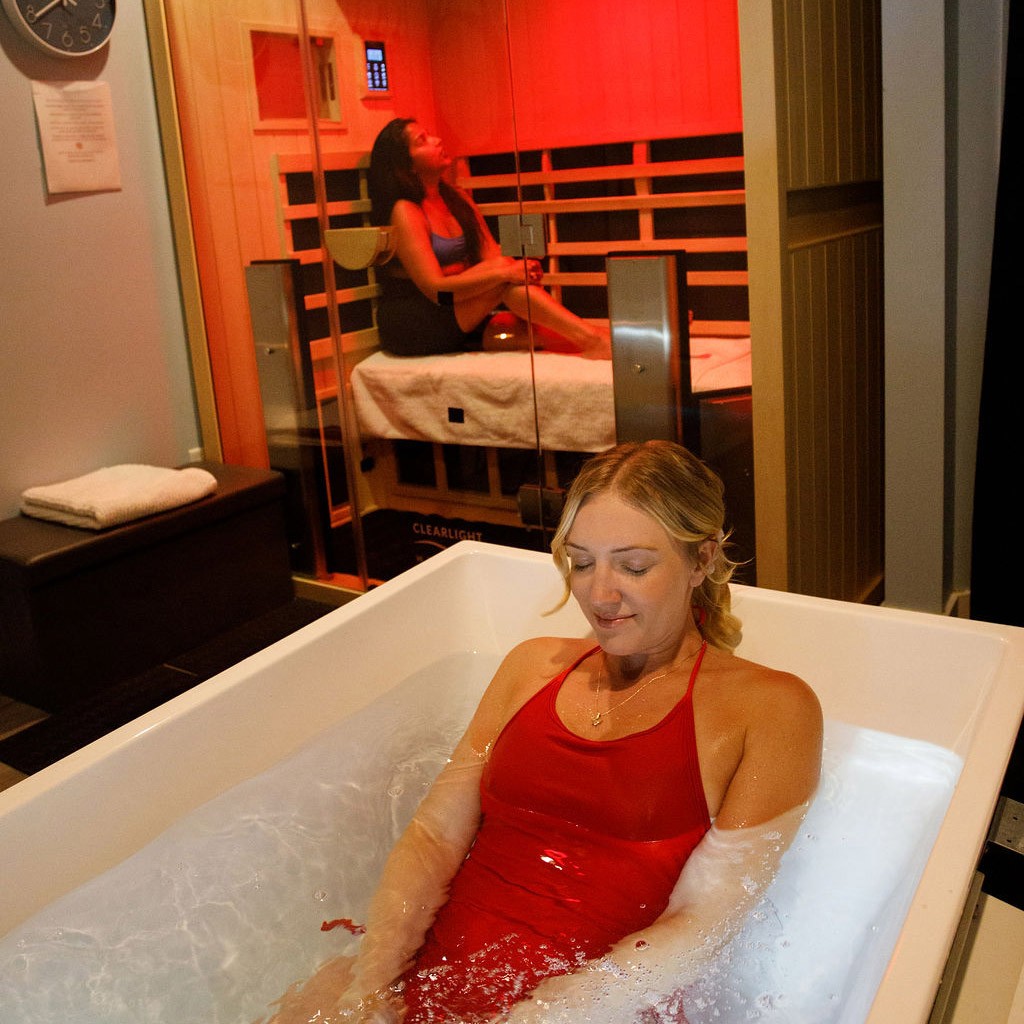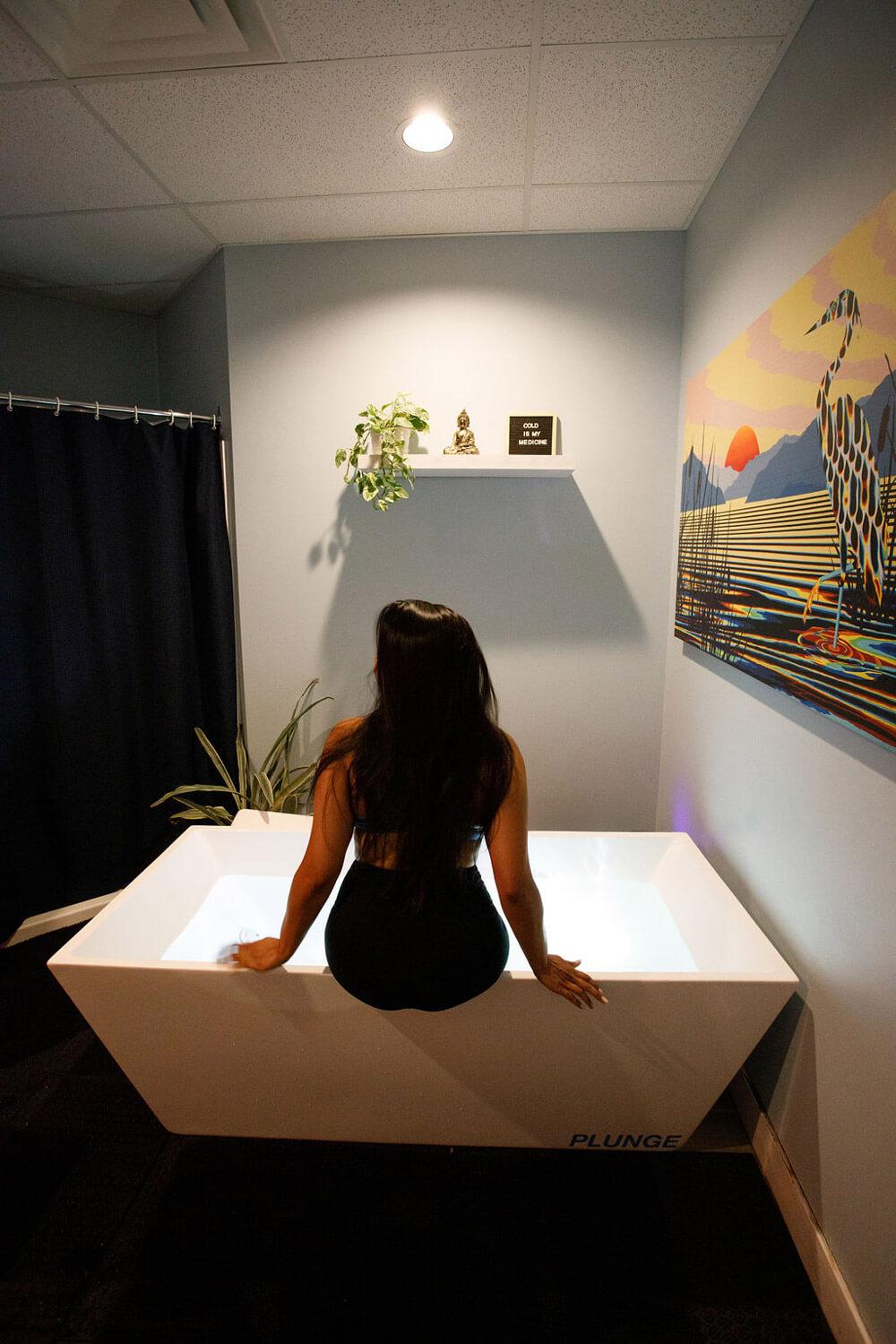Sweat + Chill
Using an infrared sauna and cold plunge therapy together, often referred to as contrast therapy, combines the benefits of heat and cold exposure to improve overall health and recovery. This combination offers powerful physical and mental benefits by alternating between the warmth of the sauna and the intense cold of the plunge. Here’s how they work and the key benefits:
80 minutes duo
60 minutes solo
60 minutes duo
40 minutes solo
40 minutes duo
Sweat + Chill
Indulge in a private sauna and cold plunge experience tailored just for you, whether you’re on your own, with a partner, or sharing the moment with up to two other friends.
Choose from 40, 60, or 75-minute sessions to fully immerse yourself in contrast hydrotherapy, alternating between our invigorating infrared sauna and the exhilaratingly cold plunge.
Our Clearlight Infrared Sauna boasts three full-spectrum heaters, medical-grade chromotherapy, heating up to 75 degrees Celsius, and Bluetooth connectivity for you to enjoy your favourite podcasts or music while achieving ultimate relaxation, stress relief, and detoxification.
Dive into our cold plunge circulating tub, cooling down to nearly 4 degrees Celsius, enhancing the ‘chill’ factor in your sauna experience.

Improved circulation
Reduced muscle soreness and inflammation
Detoxification
Improved Skin Health
Boosted Immune Function
Reduced Inflammation and Swelling
Enhanced Recovery
Improved Circulation
Boosted Immunity
Fat Loss
Frequently Asked Questions
What is contrast hydrotherapy?
Contrast hydrotherapy is a therapeutic practice that involves alternating between hot and cold water exposure. This can be done using various methods, such as infrared saunas and cold plunges, hot baths followed by cold showers, or using a hot tub and ice bath. The combination of heat and cold stimulates circulation, reduces inflammation, and supports recovery.
How does contrast hydrotherapy work?
The heat from a sauna or hot bath dilates (expands) blood vessels and increases circulation, while cold exposure (cold plunge or ice bath) constricts (shrinks) blood vessels. This alternating process enhances blood flow, improves oxygen delivery, and aids in the removal of waste products like lactic acid, speeding up recovery and reducing inflammation.
What are the main benefits of contrast hydrotherapy?
Contrast hydrotherapy offers several physical and mental health benefits:
- Improved circulation
- Reduced muscle soreness and inflammation
- Faster recovery after exercise
- Boosted immune system
- Stress relief and relaxation
- Improved mental clarity and mood
- Enhanced skin health
- Improved joint mobility
How long should I spend in each phase (hot and cold)?
The exact time can vary based on your tolerance and the type of therapy:
- Hot Phase (Sauna/Bath): 10-20 minutes in an infrared sauna or hot bath to induce sweating and increase circulation.
- Cold Phase (Cold Plunge/Ice Bath): 1-3 minutes in a cold plunge or ice bath (water around 50°F/10°C) to reduce inflammation and constrict blood vessels.
- Repeat the cycle 2-3 times, and it’s recommended to finish with cold therapy to lock in the anti-inflammatory benefits.
How often can I do contrast hydrotherapy?
For general wellness and recovery, 2-3 times per week is recommended. Athletes or those undergoing intense physical training may use it more frequently, but always listen to your body and avoid overdoing it. Start slow if you’re new to cold immersion.
Can contrast hydrotherapy help with muscle recovery?
Yes. Alternating between hot and cold therapy enhances blood flow to muscles, removes waste products, reduces muscle soreness, and accelerates recovery after intense exercise or injury. It’s commonly used by athletes to reduce delayed onset muscle soreness (DOMS).
Is contrast hydrotherapy safe for everyone?
Not necessarily. Individuals with certain health conditions, such as heart disease, high or low blood pressure, Raynaud’s disease, or those who are pregnant should consult a healthcare provider before engaging in contrast hydrotherapy. If you’re unsure, seek medical advice to ensure it’s safe for you.
Should I end with hot or cold?
It’s generally recommended to end with cold therapy. The cold plunge constricts blood vessels and reduces inflammation, helping to seal in the benefits of contrast therapy and aiding in muscle recovery.
What should I wear during contrast hydrotherapy?
In saunas, people often wear minimal clothing, such as swimwear or towels. For cold plunges or ice baths, wearing swimwear or light clothing is common. In private setups, some may choose to go without clothing, depending on comfort and privacy levels.
How cold does the cold plunge need to be?
For cold immersion, the water temperature is typically between 50°F to 59°F (10°C to 15°C). For more experienced individuals, colder temperatures can be used, but it’s important to listen to your body and avoid overexposure to extreme cold.
How quickly will I notice the benefits?
Many people experience immediate benefits, such as improved relaxation and mental clarity, after the first session. For long-term benefits like reduced muscle soreness, improved circulation, and better recovery, regular use over several weeks is recommended.
Can contrast hydrotherapy improve my sleep?
Yes. The relaxation and endorphin release from the sauna, combined with the cold plunge’s ability to reduce inflammation and reset your body’s internal temperature, can lead to deeper, more restful sleep.
Is it normal to feel lightheaded or dizzy during contrast therapy?
Some people may feel lightheaded or dizzy, especially when moving from hot to cold environments due to changes in blood pressure. If this happens, take it slow, sit down, and focus on deep breathing. Always listen to your body and don’t push past discomfort.


